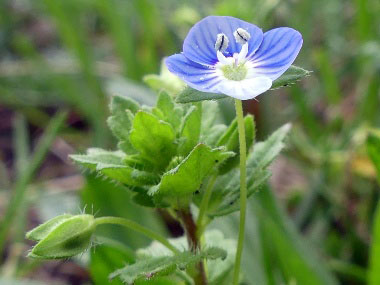







To support our efforts please browse our store (books with health benefits, etc.).
Field Speedwell is a winter or spring annual plant that grows worldwide. This common neophytic edible weed is native to southwest Asia and parts of Europe. Also commonly known as Persian Speedwell, Common Field Speedwell, or Bird's-eye Speedwell, this plant is in the Plantaginaceae family. The Latin name of this blue flowered plant comes from a woman. Veronica, (canonized Saint Veronica in 1885) gave Jesus her veil to wipe his brow as he carried the cross through Jerusalem. Her veil supposedly had markings on it that resembled this flower. The common name “speedwell” comes from the parting words “God be with you” or “go on well,” referring to the healing powers of some Veronica species.
Distinguishing Features
Common Field Speedwell is an easy to spot plant when flowering. However, it can be easily confused with Gray Field Speedwell. The main differences between Veronica persica and Veronica polita are the leaves. Both species have short petioles, but the leaf shape of the common field speedwell is mostly widely ovate. Gray Field Speedwell leaves tend to be ovate–broadly elliptic. They are often shiny, virtually glabrous, and deeply serrated whereas Common Field Speedwell is generally light green and large-toothed. Both are edible.
Flowers
Flowers are about 1cm (1/3") across with four round lobes, they are bright blue to blue-violet, white at the base and lined with darker streaks. Projecting from the tube are two white stamens and a single style. The calyx surrounding the flower has four lance to egg-shaped lobes slightly shorter than the petals, hairless to sparsely hairy on the surface with a fringe of short hairs along the edges.
 Fields
of Nutrition has medicinal benefits and vitamin/mineral content of Field Speedwell.
Fields
of Nutrition has medicinal benefits and vitamin/mineral content of Field Speedwell.
Leaves
Leaves grow opposite, sometimes becoming alternate on the upper stem. Leaf blades are widely ovate, 0.84 to 1.9cm (1/3 to 3/4") long, and are usually a bit longer than wide. Leaves are blunt to pointed at the tip. The upper surface is sparsely hairy, underneath is mostly hairy along the veins. Leaves are light green.
Height
A limp ascending stem measures 5 to 30 cm (2 to 12") and it sparsely haired. Stems are usually sprawling. Prostrate stems may root at the nodes and form small mats.
Habitat
This speedwell prefers partial to full sun, moist conditions, and a rich loamy soil. It will adapt to rocky and other kinds of poor soil. Most vegetative growth and development occurs during the cool weather of spring, when moisture amounts are higher. This plant is usually found in areas of human disturbance such as lawns, gardens, farms, and in empty lots.
Edible Parts
The leaves are best before flowering and can be used in salads or in casseroles, soups, etc. The young growth tips are edible through the spring and summer. Speedwells are well recognized as having antioxidant properties.
Other Name
Bird's-Eye Speedwell.
Winter Survival Food Handbook

PDF Plant Magazines
Types of Wild Food
Geographic Zones Seasons
Disclaimer
EdibleWildFood.com is informational in nature. While we strive to be 100% accurate, it is solely up to the reader to ensure proper plant identification. Some wild plants are poisonous or can have serious adverse health effects.
We are not health professionals, medical doctors, nor are we nutritionists. It is up to the reader to verify nutritional information and health benefits with qualified professionals for all edible plants listed in this web site. Please click here for more information.
Why Edible Wild Food?
- Food costs are rising
- Free, wild food is readily abundant
- Wild food adds nutrition to your diet
- Wild food can help treat various medical conditions





